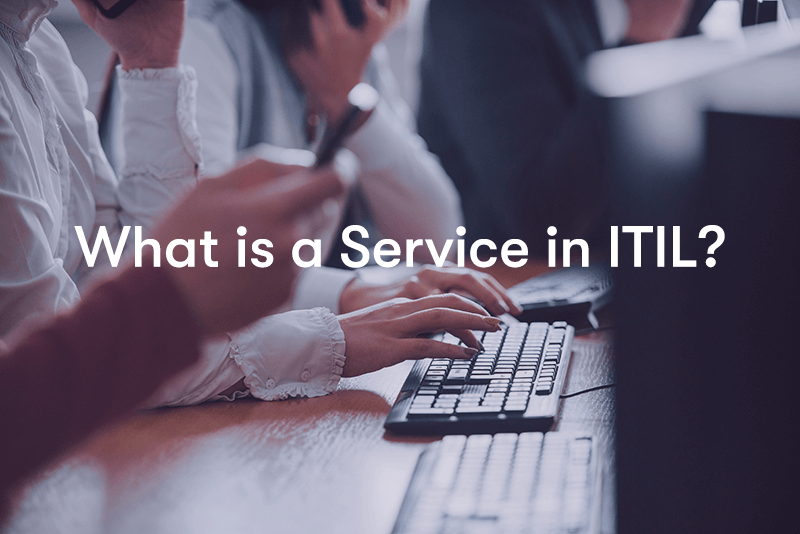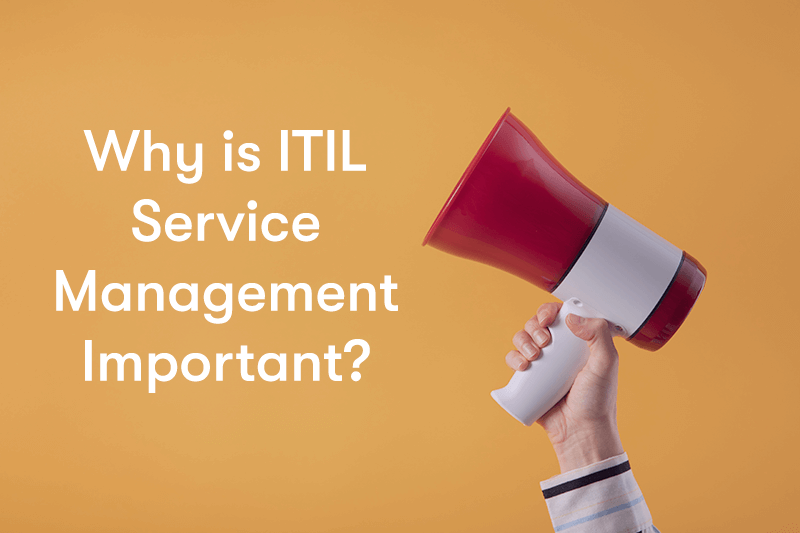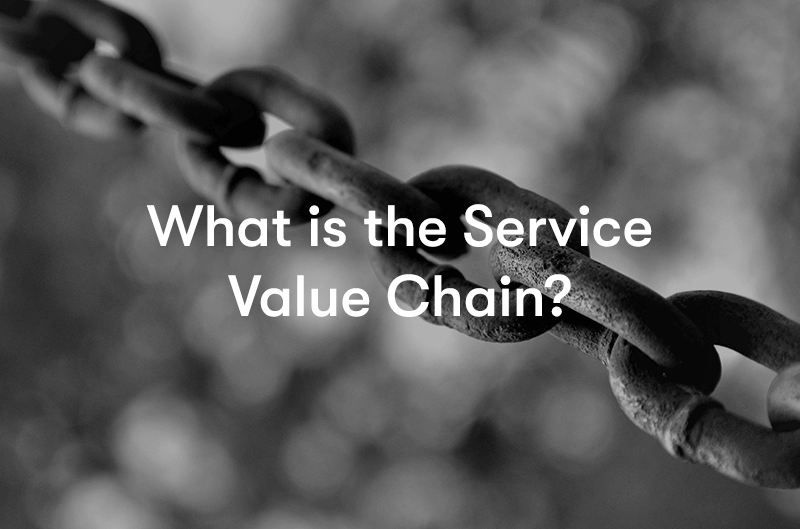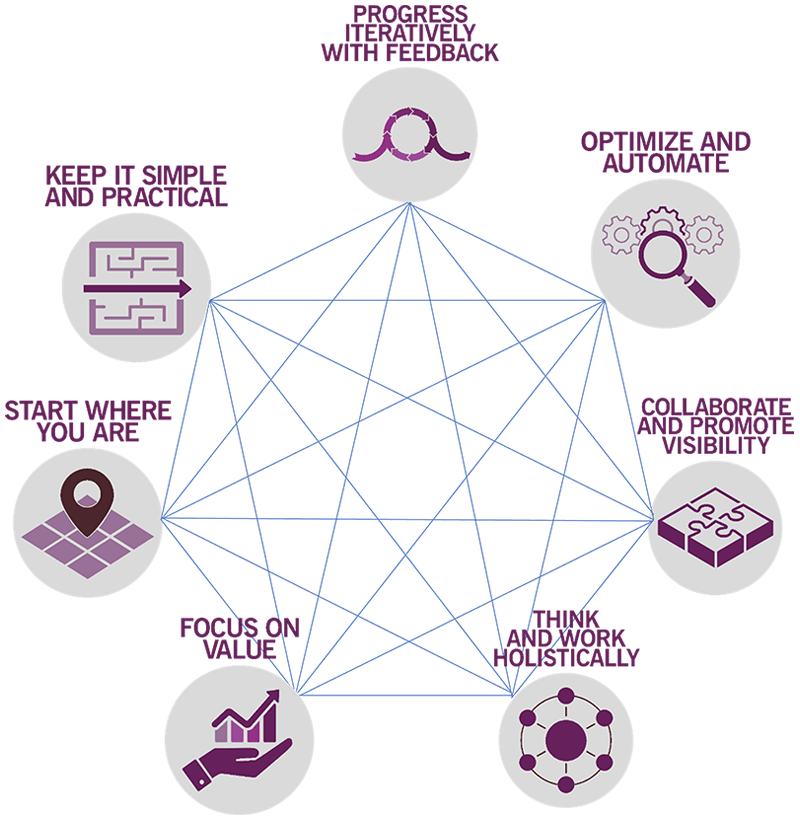ITIL 4 provides a comprehensive framework and set of best practices for organisations to effectively manage their IT services.
By adopting ITIL 4, your organisation can achieve better alignment between IT and business objectives, enhance customer satisfaction, drive value creation, and foster a culture of continuous improvement in their IT service management processes.
ITIL 4 is important and beneficial as it provides a comprehensive framework and set of best practices to effectively manage IT services.
- What Is ITIL® Service Management?
- What is a Service in ITIL?
- What is Service Management in ITIL?
- Why is ITIL Service Management Important?
- What are the main Functions and Processes in ITIL?
- What is the Service Value System?
- What is the Service Value Chain?
- What are the Guiding Principles of ITIL Service Management?
- What are the Roles Within Service Management for ITIL?
- How does Governance Relate to Management of Services?
- Final notes on ITIL Service Management
What Is ITIL® Service Management?
Service management refers to the set of activities and processes that are used to design, deliver, operate, and improve the services that an organisation provides to its customers.
It is a systematic approach to managing services, which involves the coordination of people, processes, technology, and information to ensure that services are delivered effectively and efficiently.
Service management includes a range of activities, such as service design, service level management, incident management, problem management, change management, and service continuity management.
These activities are typically organised into a framework or methodology, such as ITIL (Information Technology Infrastructure Library), which provides a set of best practices for managing services.
Service management is important for organisations because it helps to ensure that services are delivered in a consistent and reliable manner, which can improve customer satisfaction and loyalty.
It also helps organisations to optimise their service delivery processes and identify areas for improvement, which can increase efficiency and reduce costs.
What is a Service in ITIL?

ITIL refers to a service as "A means of co-creating value to customers by facilitating outcomes customers want to achieve without the ownership of specific costs and risks.
The term ‘service’ is sometimes used as a synonym for core service, IT service or service package."
This definition emphasises that a service is not just a product or technology, but a way of providing value to customers through the delivery of outcomes that meet their needs and expectations.
It also highlights that customers do not necessarily need to own the costs and risks associated with the delivery of the service. ITIL further categorises services into two main types:
Customer-facing services
These are services that are delivered directly to the customer and are visible to them, such as online banking, email, or customer support.
Supporting services
These are services that are required for the delivery of customer-facing services, but are not visible to the customer, such as data center management, network monitoring, or software development.
Overall, the ITIL definition of a service is focused on delivering value to customers through the delivery of outcomes, rather than just providing technology or products.
What is Service Management in ITIL?
ITIL 4 defines service management as:
“A set of specialised organisational capabilities for enabling value for customers in the form of services”
In ITIL 4, service management is a set of organisational capabilities that enable value for customers in the form of services.
It is a holistic approach that focuses on the end-to-end value chain of service delivery, from demand to value realisation, and emphasises the importance of collaboration, integration, and automation across the organisation.
The ITIL 4 service management framework consists of four dimensions, which are:
Organisations and people: This dimension focuses on the roles, responsibilities, skills, and culture required to support service management.
Information and technology: This dimension focuses on the tools, systems, and data required to support service management.
Partners and suppliers: This dimension focuses on the relationships and collaborations required to support service management, both internally and externally.
Value streams and processes: This dimension focuses on the end-to-end activities required to design, develop, deliver, and support services, and includes practices such as service design, service transition, service operation, and continual improvement.
In ITIL 4, service management is also based on a service value system (SVS), which is a model that describes how different components of an organisation work together to deliver value to customers. The SVS consists of six key components, which are:
Guiding principles: These are the fundamental beliefs and values that guide an organisation's decision-making and behaviour.
Governance: This component focuses on the policies, rules, and decision-making processes that enable effective service management.
Service management practices: These are the specific activities and processes used to manage services throughout their lifecycle.
Continual improvement: This component focuses on the ongoing monitoring and improvement of services to ensure they continue to meet customer needs and expectations.
ITIL practices: These are the specific practices and techniques defined in the ITIL framework, which provide guidance on how to manage services effectively.
The service value chain: This component describes the sequence of activities required to create and deliver value to customers, and includes activities such as plan, improve, engage, design and transition, obtain/build, and deliver and support.
Overall, service management in ITIL 4 is a comprehensive approach that integrates people, processes, technology, and information to deliver value to customers through the effective management of services.
Why is ITIL Service Management Important?

ITIL 4 service management is important because it provides a comprehensive and flexible framework for effective service management.
It emphasizes the importance of delivering value to customers, continuous improvement, and collaboration between different parts of an organisation.
Some key reasons why ITIL 4 is important include:
- Aligning services with customer needs and expectations to improve customer satisfaction and loyalty.
- Providing a more flexible and agile approach to service management that is better suited to modern business environments.
- Encompassing the entire value chain of service delivery, from demand to value realization, to identify and address gaps or inefficiencies in service delivery processes.
- Promoting better communication and collaboration between different parts of an organization to improve alignment between different stakeholders.
- Optimizing service delivery processes to increase efficiency and reduce costs.
- Providing a structured and consistent approach to service management that enables continual improvement and innovation.
ITIL 4 is important because it helps organisations to deliver high-quality services that meet or exceed customer expectations, improve efficiency, reduce costs, and stay competitive in a rapidly changing business environment.
Customer satisfaction
ITIL service management helps organizations to deliver services that meet or exceed customer expectations.
By focusing on customer needs and outcomes, service management can improve customer satisfaction, loyalty, and retention.
Service quality
ITIL service management provides a structured approach to service design, delivery, and improvement.
This can improve service quality by ensuring that services are delivered consistently, reliably, and efficiently.
Cost efficiency
ITIL service management can help organisations to optimise their service delivery processes and reduce costs.
By identifying areas for improvement, organisations can streamline their operations, reduce waste, and increase efficiency.
Risk management
ITIL service management includes processes for managing and mitigating risks, such as incident management, problem management, and service continuity management.
This can help organisations to avoid or minimise the impact of service disruptions and ensure business continuity.
Continuous improvement
ITIL service management emphasises the importance of continual improvement, which involves monitoring and improving services over time.
This can help organisations to stay competitive, adapt to changing customer needs, and innovate new services.
What are the main Functions and Processes in ITIL?

ITIL 4 enables co-creation of value by facilitating outcomes that customers want to achieve without the customer having to manage specific costs and risks.
Some of the main functions and processes in ITIL 4 that underpin service delivery include:
Service desk
The service desk provides a single point of contact for customers to report incidents, make service requests, and receive information and support.
Incident management
Incident management is the process of managing and resolving incidents to minimise the impact on the organisation and restore normal service as quickly as possible.
Problem management
Problem management is the process of identifying and resolving the root cause of incidents to prevent them from recurring.
Change management
Change management is the process of managing changes to services, infrastructure, or other aspects of the IT environment to minimise disruption and ensure that changes are properly planned and approved.
Service level management
Service level management is the process of defining, agreeing on, and monitoring service levels to ensure that services are delivered in line with customer expectations.
Service catalogue management
Service catalogue management is the process of creating and maintaining a catalogue of services that are available to customers, including details of service levels, costs, and other relevant information.
Service reporting and analytics
Service reporting and analytics involve collecting, analysing, and reporting on service performance data to support decision-making and continuous improvement.
These are just some of the main functions and processes in ITIL 4.
The framework is designed to be flexible and adaptable, so organisations can tailor their service management practices to their specific needs and circumstances.
What is the Service Value System?

The ITIL 4 Service Value System (SVS) is a framework that provides a holistic approach to service management. It is designed to help organisations create, deliver, and continually improve services that provide value to their customers and stakeholders.
The SVS is composed of several components that work together to enable effective service management:
Service Value Chain
The Service Value Chain is a series of interconnected activities that describe the stages involved in creating and delivering a service.
The activities include Plan, Improve, Engage, Design & Transition, Obtain/Build, Deliver & Support.
Service Value Streams
Service Value Streams are specific sequences of activities that are designed to achieve specific outcomes for customers and the organisation.
They are used to improve the efficiency and effectiveness of service delivery.
Practices
Practices are sets of organisational resources and capabilities that are used to perform specific tasks and achieve specific objectives.
ITIL 4 defines 34 Practices that are grouped into three categories: General Management, Service Management, and Technical Management.
Guiding Principles
Guiding Principles are a set of recommendations and best practices that help organisations make better decisions, improve their processes, and deliver high-quality services that meet the needs of their customers and stakeholders.
Governance
Governance is the system of management, controls, and processes that ensure that an organisation's resources are used in a responsible and effective way to achieve its goals and objectives.
Continual Improvement
Continual Improvement is a key component of the ITIL 4 SVS.
It involves an ongoing process of reviewing and improving the organisation's service management practices, to ensure that they are aligned with the organisation's goals and objectives and are delivering value to its customers and stakeholders.
Overall, the ITIL 4 Service Value System provides a comprehensive framework for service management that helps organisations to create, deliver, and continually improve services that provide value to their customers and stakeholders.
By adopting the ITIL 4 SVS, organisations can achieve greater efficiency and effectiveness in their service delivery, and improve their overall business outcomes.
What is the Service Value Chain?

The Service Value Chain (SVC) is a key component of the ITIL 4 Service Value System.
It is a series of interconnected activities that describe the stages involved in creating and delivering a service.
The SVC provides a flexible and adaptable framework for service providers to plan, design, develop, deliver, and support their services.
The SVC consists of six primary activities, each of which is designed to create value for the customer:
Plan
This activity involves defining the organisation's strategic objectives and identifying the services required to achieve them.
It includes defining the scope of the services, understanding customer needs, and developing service strategies and plans.
Improve
This activity focuses on continual improvement of the organisation's service management practices.
It involves monitoring and measuring performance, identifying areas for improvement, and implementing changes to improve service quality and efficiency.
Engage
This activity involves building and maintaining positive relationships with customers, stakeholders, and other service providers.
It includes understanding customer expectations, managing communication channels, and ensuring that customers and stakeholders are engaged throughout the service lifecycle.
Design and Transition
This activity involves designing and developing new services, as well as transitioning them into the operational environment.
It includes designing service solutions, testing and validating new services, and ensuring that they are ready for deployment.
Obtain/Build
This activity involves obtaining or building the necessary resources and capabilities to support the delivery of services.
It includes identifying and acquiring the resources required to deliver services, such as people, technology, and processes.
Deliver and Support
This activity involves delivering and supporting services to customers.
It includes managing service requests, incidents, and problems, as well as providing ongoing support to ensure that services meet customer expectations.
The SVC is designed to be flexible and adaptable, so that organisations can tailor their service management practices meeting their specific needs and requirements.
By adopting the SVC, organisations can improve the quality and efficiency of their service delivery, while ensuring that they are providing value to their customers and stakeholders.
What are the Guiding Principles of ITIL Service Management?

ITIL 4 defines 7 Service Management Principles that are fundamental to the effective and efficient management of services.
These principles can be applied to any type of service, in any type of organisation. The 7 ITIL Service Management Principles in no particular order are:
- Focus on value.
- Start where you are.
- Progress iteratively with feedback.
- Collaborate and promote visibility.
- Think and work holistically.
- Keep it simple and practical.
- Optimise and automate.
The guiding principles provide a common language and framework for service management.
They help to ensure that all stakeholders, regardless of their role or level of involvement, are aligned with the organisation's goals and objectives.
They also help to promote a culture of continuous improvement and innovation, by encouraging organisations to regularly review and refine their service management practices.
They can be used to guide strategic decision-making at the executive level, as well as operational decision-making at the tactical and operational levels.
This means that the guiding principles can help to align the organisation's overall strategy with its day-to-day service delivery activities.
Focus on value
One principle is to focus on value.
This means that all services and service management practices should be designed and delivered with a clear understanding of how they contribute to the value that customers and the business expect.
Start where you are
Another principle is to start where you are.
This means that organisations should build on their existing strengths and capabilities, while also identifying areas for improvement and change.
Progress iteratively with feedback
Another principle is to progress iteratively with feedback.
This means that service management practices should be developed and improved over time, based on feedback from customers, users, and stakeholders.
Collaborate and promote visibility
Another principle is to collaborate and promote visibility.
This means that service management practices should be developed and delivered in a collaborative way, with a focus on promoting transparency and visibility across the organisation.
Think and work holistically
Another principle is to think and work holistically.
This means that service management practices should be developed and delivered in a way that considers the entire value chain and all four dimensions of service management.
Keep it simple and practical
Another principle is to keep it simple and practical.
This means that service management practices should be designed to be as simple and practical as possible, while still meeting the needs of customers and the organisation.
Optimize and automate
Another principle is to optimize and automate.
This means that service management practices should be continuously optimized and automated, using technology and data analytics, to improve efficiency and effectiveness.
Not all seven principles will apply in every case, but should be considered when any change is taking place or being planned
These principles provide a foundation for service management that can help organisations to deliver high-quality services, improve efficiency, and achieve their strategic objectives.
What are the Roles Within Service Management for ITIL?

There are a number of generic roles within the ITIL framework which consist of:
- Process owner
- Process manager
- Process practitioner
- Service owner
Process Owner
The process owner role is responsible for the overall design, implementation, and ongoing management of a specific ITIL process within an organisation.
The process owner is accountable for the effectiveness and efficiency of the process, ensuring that it meets the needs of its users and supports the organisation's overall goals and objectives.
Defining the process scope, objectives, and performance measures: The process owner is responsible for defining the scope of the process, its objectives, and the key performance measures that will be used to assess its effectiveness.
Developing and implementing process policies and procedures: The process owner is responsible for developing and implementing the policies and procedures that govern the process, ensuring that they are aligned with industry best practices and the organization's overall goals and objectives.
Monitoring and reporting on process performance: The process owner is responsible for monitoring the performance of the process, identifying areas for improvement, and reporting on process performance to senior management and other stakeholders.
Process Manager
The process manager role is responsible for the day-to-day management and continuous improvement of a specific ITIL process within an organisation.
The process manager is accountable for ensuring that the process operates efficiently and effectively, and that it meets the needs of its users and supports the organisation's overall goals and objectives.
Implementing process policies and procedures: The process manager is responsible for implementing the policies and procedures that govern the process, ensuring that they are aligned with industry best practices and the organization's overall goals and objectives.
Monitoring process performance: The process manager is responsible for monitoring the performance of the process, using metrics and key performance indicators to identify areas for improvement.
Identifying and managing process risks: The process manager is responsible for identifying and managing process risks, ensuring that appropriate controls are in place to mitigate them.
Ensuring process compliance: The process manager is responsible for ensuring that the process is compliant with relevant laws, regulations, and standards, such as ISO 20000 and ITIL.
Communicating with stakeholders: The process manager is responsible for communicating with stakeholders, such as process owners, process users, and senior management, to ensure that the process is meeting their needs and expectations.
Process Practitioner
The Process practitioner role is responsible for performing the day-to-day activities related to a specific ITIL process within an organisation.
The process practitioner is accountable for ensuring that the process is executed correctly and efficiently, and that it meets the needs of its users and supports the organisation's overall goals and objectives.
Following process policies and procedures: The process practitioner is responsible for following the policies and procedures that govern the process, ensuring that they are executed correctly and in a timely manner.
Performing process activities: The process practitioner is responsible for performing the activities that make up the process, ensuring that they are executed efficiently and effectively.
Escalating issues and exceptions: The process practitioner is responsible for escalating issues and exceptions to the process manager or other relevant stakeholders, when necessary.
Providing feedback on process performance: The process practitioner is responsible for providing feedback on the performance of the process, identifying areas for improvement and suggesting changes that could be made to improve its effectiveness and efficiency.
Service Owner
The service owner role is responsible for the overall performance of a specific IT service within an organisation.
The service owner is accountable for ensuring that the service meets the needs of its users and supports the organisation's overall goals and objectives.
Defining the service strategy: The service owner is responsible for defining the strategy for the service, including its scope, objectives, and key performance indicators.
Defining the service requirements: The service owner is responsible for defining the requirements for the service, including the features, functions, and quality standards that it must meet.
Managing the service budget: The service owner is responsible for managing the budget for the service, ensuring that it is allocated and used effectively.
Ensuring service performance: The service owner is responsible for ensuring that the service performs as expected, monitoring its performance and identifying areas for improvement.
Managing service risks: The service owner is responsible for identifying and managing risks related to the service, ensuring that appropriate controls are in place to mitigate them.
Managing service relationships: The service owner is responsible for managing relationships with stakeholders related to the service, including customers, users, suppliers, and partners.
How does Governance Relate to Management of Services?
Governance is a critical component of the ITIL 4 Service Value System and refers to the system of management, controls, and processes that ensure that an organisation's resources are used in a responsible and effective way to achieve its goals and objectives.
Governance helps to establish a framework for decision-making, accountability, and responsibility across an organisation.
It provides guidance and direction on how to make decisions, allocate resources, manage risks, and measure performance.
ITIL 4 defines three main types of governance:
Corporate Governance
Corporate Governance is the system of management, controls, and processes that are used to direct and manage an organisation's overall performance.
It includes the processes used to define the organisation's strategic objectives and to manage risk and compliance.
IT Governance
IT Governance is the system of management, controls, and processes that ensure that IT resources are used effectively to achieve the organisation's goals and objectives.
It includes the processes used to manage IT investments, risks, and compliance, as well as the processes used to ensure the alignment of IT with the organisation's overall strategy.
Service Governance
Service Governance is the system of management, controls, and processes that ensure that services are delivered effectively and efficiently to meet customer and stakeholder expectations.
It includes the processes used to manage service performance, risk, and compliance, as well as the processes used to ensure the alignment of services with the organisation's overall strategy.
Effective governance provides a framework for decision-making and ensures that decisions are made in a structured and consistent manner. It also helps to ensure that resources are used efficiently and effectively to achieve the organisation's goals and objectives.
Governance provides a way to manage risk and compliance and helps to ensure that the organisation meets its legal, regulatory, and contractual obligations.
Governance provides guidance and direction on how to make decisions, allocate resources, manage risks, and measure performance.
By adopting effective governance practices, organisations can ensure that they are using their resources in a responsible and effective way to achieve their goals and objectives.
Final Notes on ITIL Service Management
ITIL Service Management is a framework of best practices for designing, delivering, and improving IT services that meet the needs of customers and stakeholders.
It includes a set of guidelines and processes for managing the entire lifecycle of IT services, from strategy and planning to operation and continual improvement.
Service Management for ITIL is important because it helps organisations to:
- Improve the quality of IT services by adopting a customer-focused approach.
- Increase efficiency and reduce costs by standardising processes and procedures.
- Better align IT services with the organisation's overall strategy and goals.
- Manage risk and compliance by establishing a framework for governance and control.
- Improve communication and collaboration between IT and other departments.
- Continually improve service quality by implementing a culture of continual improvement.
Overall, ITIL Service Management is a comprehensive and adaptable framework that can help organisations to deliver high-quality IT services that meet the needs of their customers and stakeholders.




